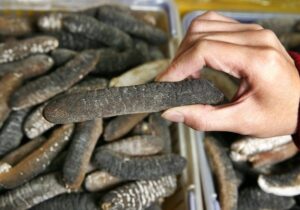
Dried sea cucumbers, often referred to as “bêche-de-mer” or “trepang,” have been valued for centuries in various cultures for their culinary and medicinal properties. These marine invertebrates, belonging to the class Holothuroidea, are harvested, processed, and traded globally, particularly in Asian markets. The trade of dried sea cucumbers has significant economic, ecological, and cultural implications. This article delves into the biology of sea cucumbers, their traditional uses, the dynamics of their trade, and the conservation challenges they face.
The Biology and Ecology of Sea Cucumbers
Sea cucumbers are echinoderms, closely related to sea stars and sea urchins. They inhabit the seafloor of oceans worldwide, from shallow coastal areas to deep-sea environments. Sea cucumbers play a crucial role in marine ecosystems by recycling nutrients, breaking down detritus, and oxygenating the sediment through their burrowing activities.
Biologically, sea cucumbers exhibit unique features. They have elongated, soft bodies with leathery skin and a mouth surrounded by tentacles. They can regenerate lost body parts, a survival strategy that helps them recover from predation and environmental damage. Sea cucumbers exhibit remarkable diversity, with over 1,700 species identified, though only a few are commercially valuable for their culinary and medicinal uses.
Traditional Uses of Dried Sea Cucumbers
Dried sea cucumbers have been prized in traditional medicine and cuisine, especially in East Asia. In Traditional Chinese Medicine (TCM), they are believed to have numerous health benefits, including boosting immunity, enhancing sexual health, improving kidney function, and reducing joint pain. Sea cucumbers are rich in bioactive compounds such as saponins, chondroitin sulfate, and various vitamins and minerals, which contribute to their medicinal properties.
Culinarily, dried sea cucumbers are considered a delicacy, often featured in festive and ceremonial dishes. They are rehydrated before cooking and used in soups, stews, and stir-fries. The texture and ability to absorb flavors make them a versatile ingredient in gourmet cuisine.
The Global Trade in Dried Sea Cucumbers
The global trade in dried sea cucumbers is a lucrative industry, with high demand driven primarily by markets in China, Hong Kong, Singapore, and other Asian countries. The trade involves several key stages: harvesting, processing, and distribution.
- Harvesting: Sea cucumbers are collected from their natural habitats using various methods, including hand gathering, diving, and trawling. Harvesting is labor-intensive and often carried out by small-scale fishers in coastal communities.
- Processing: After collection, sea cucumbers undergo several processing steps, including evisceration (removal of internal organs), boiling, salting, and drying. These processes preserve the sea cucumbers and enhance their market value. The drying process can take several days to weeks, depending on the species and desired quality.
- Distribution: Once processed, dried sea cucumbers are exported to international markets. The trade routes are complex, involving multiple intermediaries such as traders, wholesalers, and retailers. The market value of dried sea cucumbers varies significantly based on species, size, and quality.
Economic Importance
The trade of dried sea cucumbers is a critical source of income for many coastal communities, particularly in developing countries. Countries like Indonesia, the Philippines, Malaysia, and Mexico are major exporters. The high market demand and substantial economic returns drive the extensive harvesting of sea cucumbers, sometimes leading to overexploitation.
Conservation Challenges
The increasing demand for dried sea cucumbers has led to significant conservation challenges. Overharvesting and unsustainable fishing practices have caused population declines in many regions. Key challenges include:
- Overfishing: Many sea cucumber populations have been depleted due to intensive harvesting. Slow growth rates and late sexual maturity make sea cucumbers particularly vulnerable to overfishing.
- Illegal and Unregulated Trade: The lucrative nature of the trade has led to illegal and unregulated fishing, further exacerbating population declines. Weak enforcement of fishing regulations and the high value of dried sea cucumbers contribute to this issue.
- Habitat Degradation: Coastal development, pollution, and climate change impact sea cucumber habitats, reducing their populations and resilience.
- Lack of Management: Effective management of sea cucumber fisheries is often lacking, with inadequate data on population status and insufficient regulatory frameworks.
Conservation Efforts
Several conservation strategies are being implemented to address the challenges facing sea cucumber populations:
- Sustainable Harvesting Practices: Promoting sustainable harvesting practices, such as size limits and seasonal closures, can help ensure the long-term viability of sea cucumber populations. Community-based management approaches involve local fishers in the decision-making process, fostering sustainable use.
- Marine Protected Areas (MPAs): Establishing MPAs can provide safe havens for sea cucumber populations, allowing them to recover and thrive. MPAs must be effectively managed and enforced to be successful.
- Aquaculture: Sea cucumber aquaculture offers a potential solution to reduce pressure on wild populations. Successful aquaculture initiatives can supply the market demand for dried sea cucumbers, providing an alternative source and supporting conservation efforts.
- Research and Monitoring: Continued research and monitoring are essential for understanding sea cucumber populations and the impacts of harvesting. Data collection on species distribution, population dynamics, and trade patterns can inform effective management and conservation policies.
- International Collaboration: Addressing the challenges of sea cucumber conservation requires international collaboration. Countries involved in the trade must work together to implement and enforce regulations, share best practices, and support sustainable use initiatives.
Ethical Considerations
The trade in dried sea cucumbers also raises ethical questions regarding sustainability and the rights of local communities. Balancing economic benefits with conservation goals requires careful consideration of the social and economic contexts in which sea cucumber fisheries operate.
- Community Involvement: Involving local communities in conservation and management efforts is crucial. Empowering fishers through education and capacity-building initiatives can promote sustainable practices and ensure that they benefit from the trade.
- Consumer Awareness: Increasing consumer awareness about the ecological impacts of dried sea cucumber consumption can drive demand for sustainably sourced products. Eco-labeling and certification schemes can help consumers make informed choices.
- Fair Trade Practices: Ensuring fair trade practices in the sea cucumber industry can improve the livelihoods of fishers and reduce the incentives for illegal and unsustainable harvesting. Transparency in the supply chain and equitable distribution of benefits are key components.
Conclusion
The world of dried sea cucumbers is complex and multifaceted, encompassing biological, economic, cultural, and ethical dimensions. While they hold significant value in traditional medicine and cuisine, the unsustainable harvesting and trade of sea cucumbers pose serious conservation challenges. Addressing these challenges requires a holistic approach that includes sustainable harvesting practices, effective management, community involvement, and international cooperation.
By promoting sustainable use and conservation, we can ensure that sea cucumbers continue to play their vital roles in marine ecosystems and support the livelihoods of coastal communities. Through education, research, and collaborative efforts, we can work towards a future where the trade in dried sea cucumbers is sustainable, ethical, and beneficial for all stakeholders involved.
